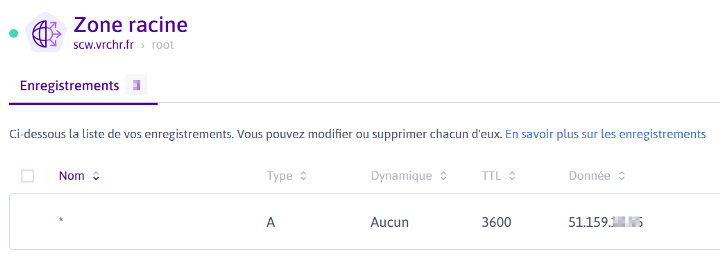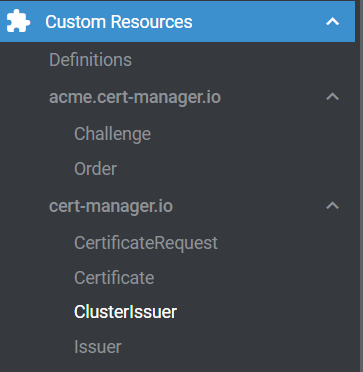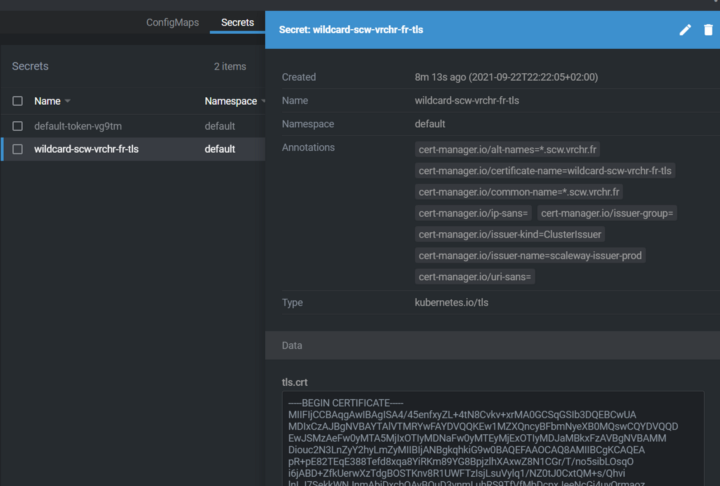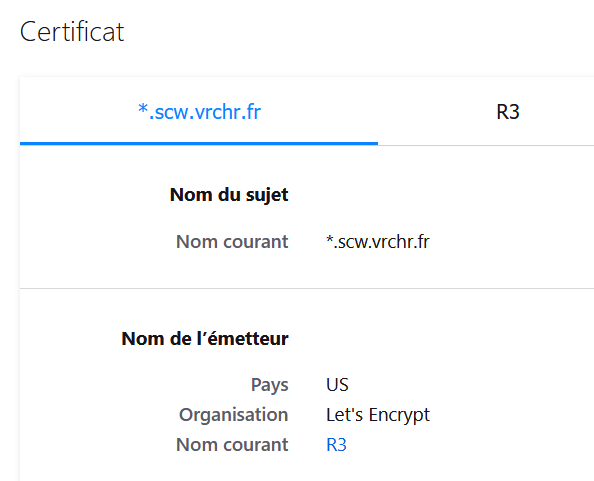DNS-01 challenge: Certificats wildcard TLS sur Kubernetes
When deploying applications on a Kubernetes cluster, we often expose them outside using ingress controllers, and using cert-manager to manage TLS certificates with Let’s Encrypt. When requesting certificates, the most common way is to use the HTTP-01 challenge, that checks if you can host content on a specific URL.
Sometimes you can use another challenge type, called DNS-01: Let’s Encrypt checks a specific DNS entry, to be sure you own the domain you requested the certificate for. This can be useful for some use cases:
Applications that are not exposed to Internet (Let’s Encrypt cannot connect to the URL content) Wildcard certificates, as there is no default URL to store content You can read more about it here: https://letsencrypt.org/docs/challenge-types/
To request such a certificate in a Kubernetes cluster, you need to automatically update the DNS records from your provider. Only major cloud providers are natively supported by default, but you can extend it using webhooks.
In this article, we will see how to quickly set up a k8s cluster, configuring cert-manager to handle DNS-01 challenge and get wildcard certificates.
Setup & Prerequisites
For this setup, I will use the following platform and tools:
- Scaleway Kubernetes Kapsule to bootstrap a k8s cluster
- Scaleway DNS, as we can manage it with cert-manager webhooks
- Terraform to quickly setup everything
- k8s Lens to easily view the k8s resources
I will not cover Terraform installation or other kubectl & helm tools, you can find good resources somewhere else.
Cluster provisioning
Using Terraform, you can provision a Kapsule cluster. We just use a scaleway_k8s_cluster and a scaleway_k8s_pool resource:
1terraform {
2 required_providers {
3 scaleway = {
4 source = "scaleway/scaleway"
5 version = "2.1.0"
6 }
7 }
8 required_version = ">= 0.13"
9}
10
11provider "scaleway" {
12 zone = "fr-par-1"
13 region = "fr-par"
14}
15
16resource "scaleway_k8s_cluster" "k8s_cluster" {
17 name = var.k8s_cluster_name
18 version = "1.22.2"
19 cni = "cilium"
20}
21
22resource "scaleway_k8s_pool" "k8s_pool" {
23 cluster_id = scaleway_k8s_cluster.k8s_cluster.id
24 name = var.k8s_pool_name
25 node_type = "DEV1-M"
26 size = 2
27 autohealing = true
28}
29
30resource "local_file" "kubeconfig" {
31 content = scaleway_k8s_cluster.k8s_cluster.kubeconfig[0].config_file
32 filename = "${path.module}/${scaleway_k8s_cluster.k8s_cluster.name}-kubeconfig"
33 file_permission = "0600"
34}
Now we can provision the cluster:
1$ terraform init
2$ terraform plan -out k8s_scaleway.out
3$ terraform apply k8s_scaleway.out
Wait few minutes and we will have a functional cluster with Nginx as an ingress controller, with a load-balancer, and a cert-manager configured. We will also find a kubeconfig file ready for playing with the cluster!
DNS Setup
We can configure DNS entry to link the load balancer IP address to our cluster domain. I could do it automatically, but there is no Terraform resource for Scaleway right now (planned for the next release, see here).
For this setup, my domain is scw.vrchr.fr, so any URL ending with it will be redirect to the k8s cluster through the load balancer.

Edit: the cluster just created does not exists anymore as you are reading this, as it was only online for this article. So don’t try to resolve the following FQDN ;)
Wildcard Certificate with DNS-01
Scaleway webhook
Remember, for some providers we need to use cert manager webhooks to manage the DNS entries. So we install it:
1$ git clone https://github.com/scaleway/cert-manager-webhook-scaleway.git
2$ cd cert-manager-webhook-scaleway
3$ helm install scaleway-webhook deploy/scaleway-webhook --set secret.accessKey=changeme --set secret.secretKey=changeme --set certManager.serviceAccountName=jetstack-cert-manager --namespace=cert-manager
Be careful of the serviceAccountName which has to be the same as the one created with the cert-manager Helm chart.
So now we can see, using our preferred tool, the deployments and all the cert-manager configs and custom resources:


Issuer and Certificates
Next, we have to create a certificate issuer, which will be responsible to request the TLS certificates. This is a Custom Resource, with the property “dns01”. We create a ClusterIssuer instead of Issuer to be able to manage certificates cluster-wide:
1---
2apiVersion: cert-manager.io/v1
3kind: ClusterIssuer
4metadata:
5 name: scaleway-issuer-prod
6spec:
7 acme:
8 email: name@company.com
9 server: https://acme-v02.api.letsencrypt.org/directory
10 privateKeySecretRef:
11 name: scaleway-private-key-secret
12 solvers:
13 - dns01:
14 webhook:
15 groupName: acme.scaleway.com
16 solverName: scaleway1$ kubectl apply -f cert_issuer.yaml
We can add another issuer for staging certificates if needed.
Now, Let’s create a certificate request! We’ll make request one for “*.scw.vrchr.fr”, which will be stored in a secret called “wildcard-scw-vrchr-fr-tls”:
1apiVersion: cert-manager.io/v1
2kind: Certificate
3metadata:
4 name: wildcard-scw-vrchr-fr-tls
5 namespace: default
6spec:
7 dnsNames:
8 - "*.scw.vrchr.fr"
9 issuerRef:
10 name: scaleway-issuer-prod
11 kind: ClusterIssuer
12 secretName: wildcard-scw-vrchr-fr-tls
What happens now?
Let’s Encrypt detects a Certificate Request, and makes the request to the servers It uses the webhook to create a TXT DNS entry, here it’s : _acme-challenge.scw.vrchr.fr The server will check the DNS entry, and validate the request. Be patient, DNS propagation can be long… The certificate is now created, and a secret is now in you cluster!

Application deployment
OK! We have now a wildcard certificate automatically managed, so let’s use it!
We create a simple deployment, expose the application, and create an ingress rule. The important configuration is in the ingress, which specify which TLS certificate to use. We don’t need to add specific annotation for the ingress controller, as the wildcard certificate is already created and managed by the previous CRD. As we have created a wildcard, every FQDN matching the wildcard will be valid:
1[...]
2spec:
3 tls:
4 - hosts:
5 - "*.scw.vrchr.fr"
6 secretName: wildcard-scw-vrchr-fr-tls
7[...]
Here is the complete deployment, using the jpetazzo/webcolor application to expose different colors.
Deployment & Service example:
1---
2apiVersion: apps/v1
3kind: Deployment
4metadata:
5 name: green
6spec:
7 selector:
8 matchLabels:
9 app: green
10 replicas: 1
11 template:
12 metadata:
13 labels:
14 app: green
15 spec:
16 containers:
17 - image: jpetazzo/webcolor
18 name: webcolor
19
20---
21apiVersion: v1
22kind: Service
23metadata:
24 name: green
25spec:
26 ports:
27 - port: 8000
28 targetPort: 8000
29 selector:
30 app: green
Ingress:
1---
2apiVersion: networking.k8s.io/v1
3kind: Ingress
4metadata:
5 name: color-ingress
6 annotations:
7 kubernetes.io/ingress.class: nginx
8spec:
9 tls:
10 - hosts:
11 - "*.scw.vrchr.fr"
12 secretName: wildcard-scw-vrchr-fr-tls
13 rules:
14 - host: green.scw.vrchr.fr
15 http:
16 paths:
17 - path: /
18 pathType: Prefix
19 backend:
20 service:
21 name: green
22 port:
23 number: 8000
24 - host: purple.scw.vrchr.fr
25 http:
26 paths:
27 - path: /
28 pathType: Prefix
29 backend:
30 service:
31 name: purple
32 port:
33 number: 8000
34 - host: yellow.scw.vrchr.fr
35 http:
36 paths:
37 - path: /
38 pathType: Prefix
39 backend:
40 service:
41 name: yellow
42 port:
43 number: 8000
1$ kubectl apply -f dep_green.yaml
2$ kubectl apply -f wildcard_tls_ingress.yaml
Now, accessing to https://green.scw.vrchr.fr would present a wildcard certificate!



Conclusion and Remarks
We have seen here how to:
- Deploy a Kubernetes Cluster on Scaleway using Terraform
- Deploy Cert Manager and Nginx using Helm chart in Terraform
- Deploy Scaleway DNS Webhook
- Request a Wildcard Certificate using the DNS-01 protocol
- Deploy an application in a subdomain, using a ingress rule presenting the wildcard DNS
Now you can deploy many sub-application as we want, all using the same wildcard TLS certificates. For the comprehensive read, I deployed applications in the same namespace, please feel free to read cert-manager docs if you want to share certificates across multiples NS.
Note that I could use another cloud provider, but I like experiment french ones ;)
Finally, You can find code example in my GitLab repository, here : https://gitlab.com/rverchere/vrchr-k8s-dns-demo
And remember, it’s always DNS!

References
These resources were very useful to understand these concepts and write my article: